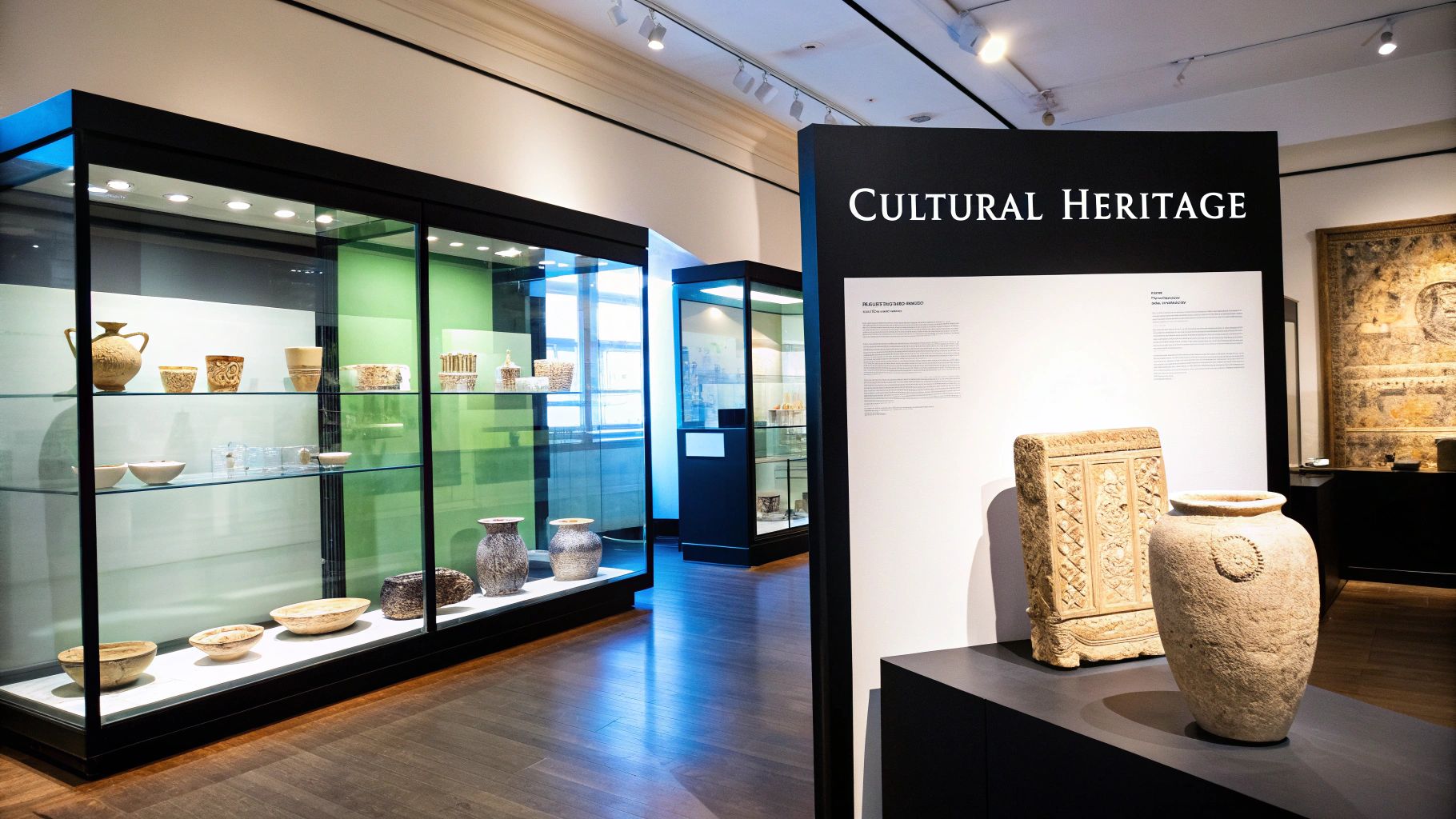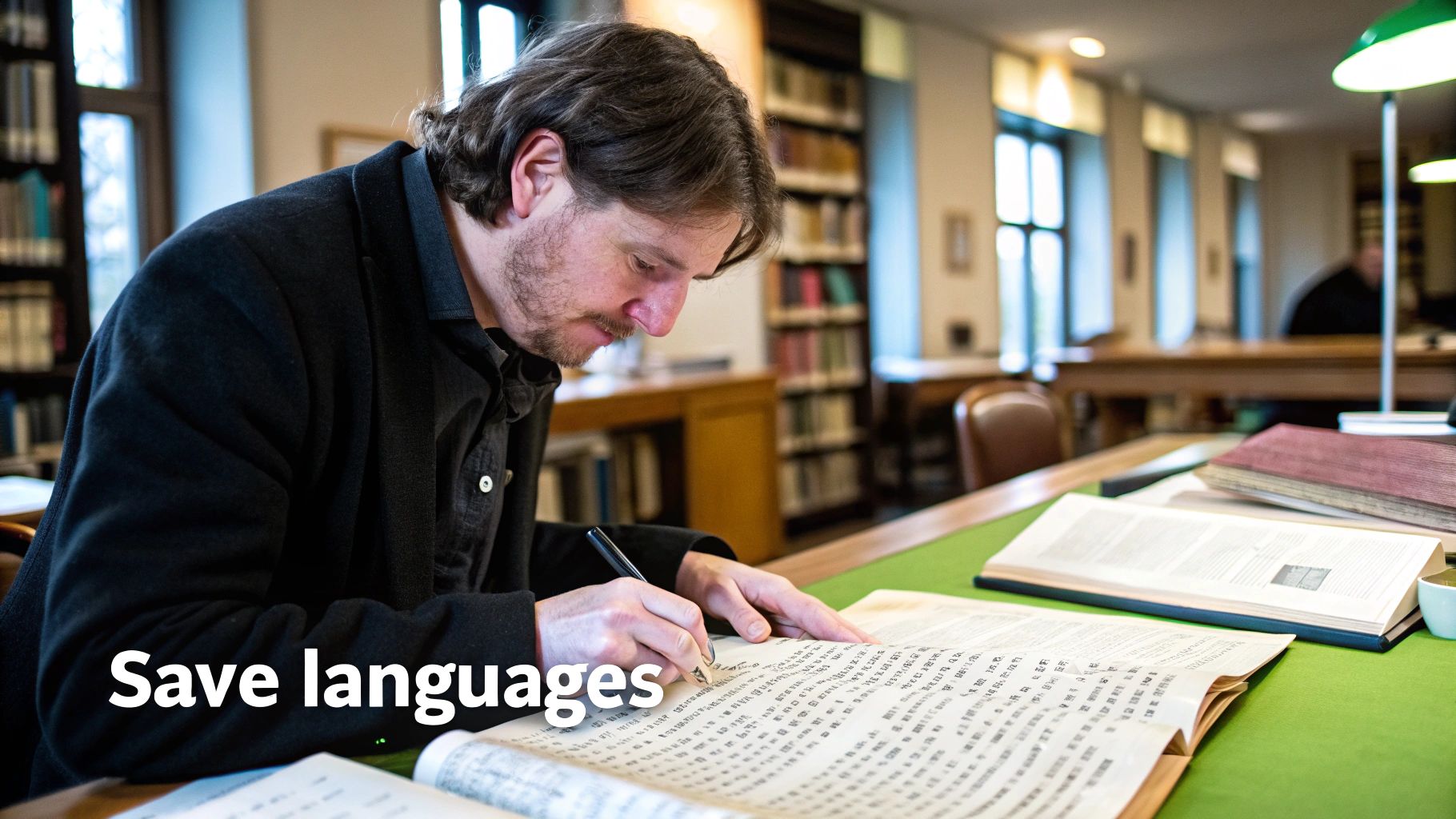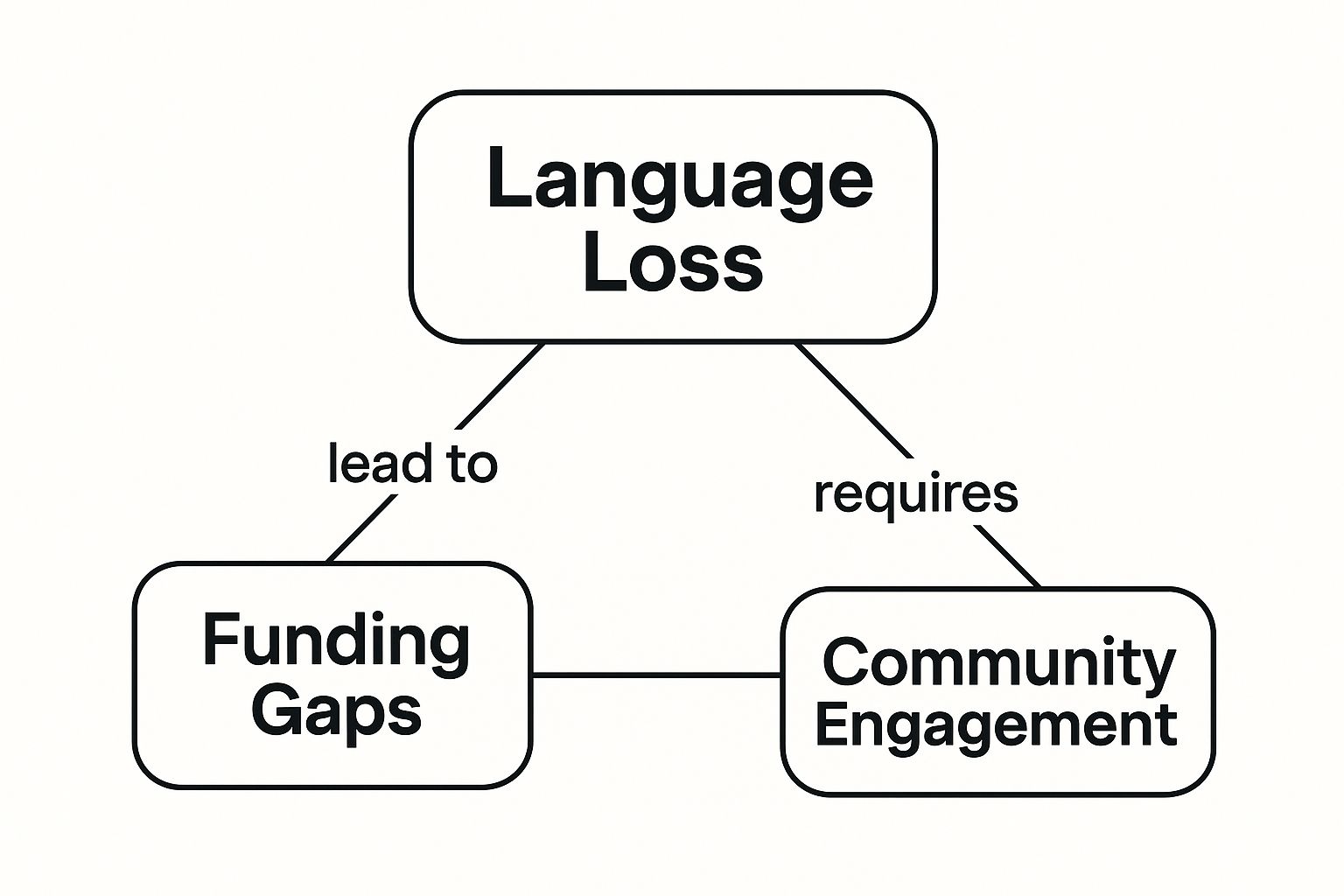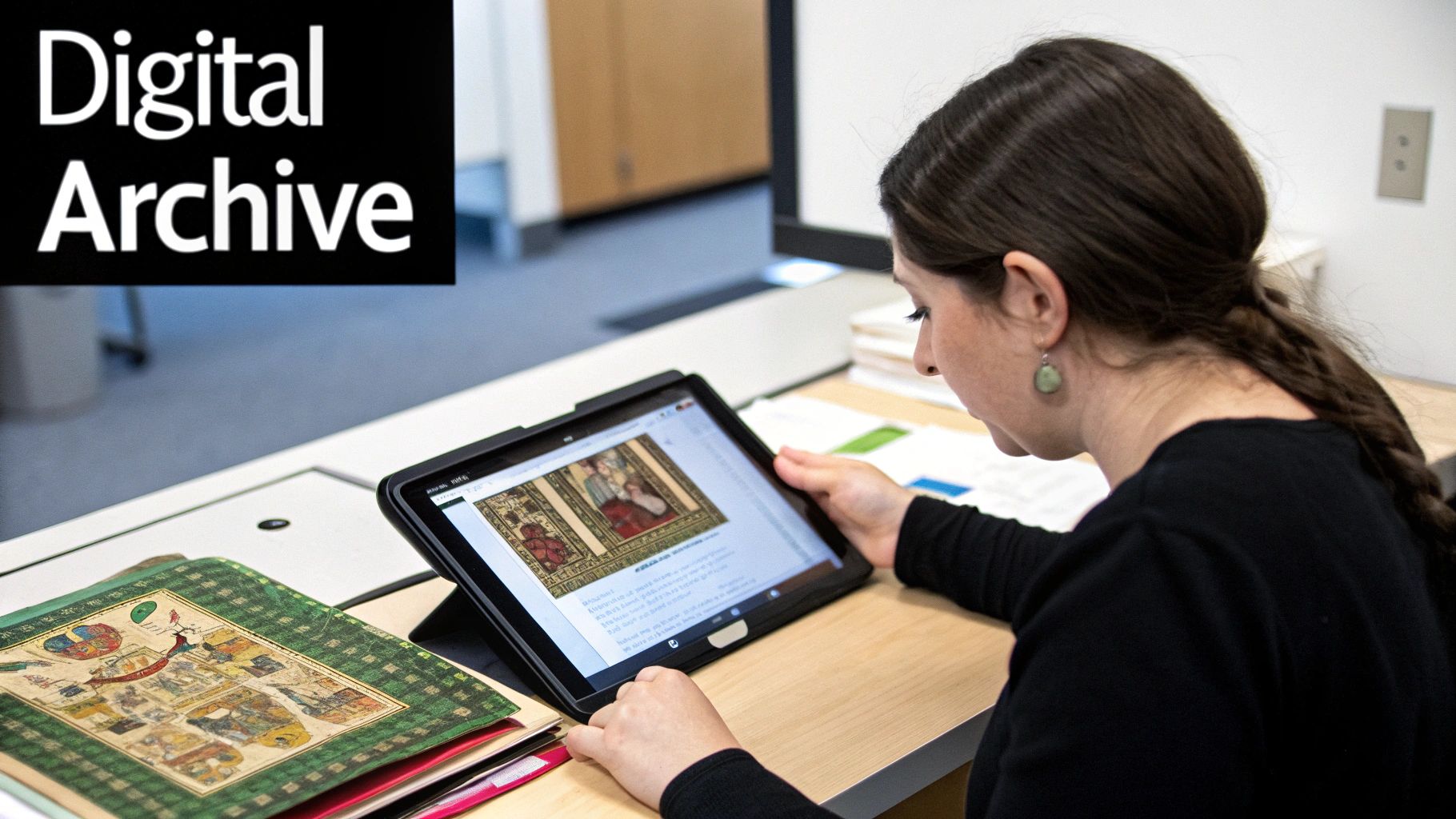When you think about a place, what comes to mind? Is it just the buildings and the streets, or is it something more? Cultural preservation is our promise to the future that we won't let that "something more" disappear. It's the dedicated work of keeping alive the heritage that gives a place its soul.
This isn't just about things you can touch. It's about protecting the stories, the music, the traditions, and the spaces that tell us who we are and where we came from, so they can continue to inspire where we're going.
Brooklyn's Heartbeat and Its Cultural Soul

Could you even picture Brooklyn without the sound of Biggie Smalls' rhymes bumping from a passing car? Or without the brilliant, joyful chaos of the West Indian Day Parade? What about the quiet, stoic beauty of its historic brownstones? These aren't just details; they are the borough's living, breathing legacy.
Cultural preservation is the force that stands guard over this soul, making sure it doesn’t get paved over and replaced by a generic, forgettable cityscape.
Some people hear "preservation" and think of places frozen in time, like artifacts in a museum case. But that’s not it at all. True preservation is about nurturing the very things that give a community its unique energy and character. It's about tending to a city’s memory so that the experiences of yesterday can continue to spark the creativity of tomorrow.
More Than Bricks and Mortar
In a place as dynamic as Brooklyn, understanding what is cultural preservation means looking far beyond the architecture. It's a living, breathing process that involves people, their stories, and their traditions. The real pulse of the borough is found in these irreplaceable parts of its identity:
- Oral Histories: Think about the effort to record the personal stories of longtime residents in neighborhoods like Bushwick and Bed-Stuy. This captures their real, lived experiences before they fade away.
- Artistic Expressions: This means protecting the incredible street art of the Bushwick Collective or fighting to support the small venues that gave birth to world-changing music like hip-hop and punk rock.
- Legacy Businesses: Did you know Coney Island's famous Cyclone roller coaster is an officially designated New York City landmark? It’s a thrilling piece of preserved history, just like the family-run pizzerias and corner bodegas that have been community anchors for generations.
This is the story of how Brooklyn keeps its irreplaceable soul alive—not as a museum piece, but as a thriving, evolving masterpiece. Each neighborhood contributes a unique verse to this ongoing poem.
From the historic cobblestones of DUMBO to the vibrant, diverse markets of Sunset Park, every corner of this borough has a story to tell. Getting to know the distinct character of each area is the first step toward understanding just how much we stand to lose. To start that journey, our comprehensive Brooklyn neighborhoods guide offers a deeper look into the communities that make this place so special.
Why Protecting Our Heritage Matters More Than Ever

In a world that seems to be in a constant state of flux, cultural preservation offers a much-needed anchor. It’s a powerful tool for building stronger communities, giving us a deep sense of belonging and reminding us that we’re all part of a story much bigger than our own.
For a place like Brooklyn, this goes way beyond just saving old buildings from the wrecking ball. It’s about stoking the creative fire that has made this borough a global icon. It’s about making sure the next generation of artists, musicians, and innovators has a rich legacy to draw from.
A Foundation for Community and Connection
When you get right down to it, cultural preservation is about people. It’s the invisible thread that connects a new family moving into a historic brownstone to all the generations who lived there before them. It's that shared pride you feel during a vibrant street festival, where neighbors from all walks of life come together to celebrate traditions from around the world.
This sense of connection is the very bedrock of a resilient community. When people feel rooted in a shared history, they become more invested in their neighborhood’s present and its future. It just makes for a stronger social fabric for everyone.
Protecting our heritage is a direct investment in our social, economic, and emotional well-being. It creates a stronger, more vibrant foundation for generations to come, ensuring Brooklyn's unique spirit never fades.
The Economic Power of Authenticity
Let’s be honest: preserving Brooklyn’s one-of-a-kind character is also just smart business. The borough’s historic districts, legendary indie music venues, and incredible street art scenes aren't just cool to look at; they are powerful economic engines. They pull in visitors from all over the globe who are searching for real, authentic experiences.
This creates a positive ripple effect, supporting local artists, small businesses, and community-based jobs. Our heritage becomes a key driver of sustainable tourism. And this isn't just a local trend. The heritage tourism market was valued at around USD 604.38 billion and is expected to climb to an incredible USD 778.07 billion by 2030. This shows that protecting local culture, like Brooklyn’s, has a massive economic impact worldwide. You can find more insights about the heritage tourism market and its incredible growth.
Building Bridges in a Diverse Borough
Brooklyn is famous for its incredible diversity—it's a true melting pot where countless cultures thrive side-by-side. Preservation acts as a bridge, sparking conversation and building mutual respect between all these different communities. By actively sharing and protecting our varied cultural traditions—from food and music to languages and festivals—we create opportunities to learn from one another.
This constant exchange makes the entire borough stronger. It proves that our differences aren't just something to be tolerated, but something to be celebrated as our greatest asset. Ultimately, understanding what is cultural preservation is about realizing that our shared past is the key to building a more connected and inspired future for everyone.
Exploring Tangible and Intangible Heritage
Culture isn't just something you can hold in your hands. It’s a feeling, a sound, a taste—an experience that resonates deep in your soul. This is the essential difference between tangible and intangible heritage, two sides of the same coin that, together, tell Brooklyn’s complete story.
Tangible heritage is the physical evidence of our past. Think of the iconic steel cables of the Brooklyn Bridge arching over the East River. It's the weathered, hand-painted signs on legacy businesses in Greenpoint or the priceless archives carefully preserved at the Center for Brooklyn History. These are the artifacts you can actually see and touch.
But what gives those physical things their profound meaning? That's where intangible heritage comes in. It’s the living, breathing soul of Brooklyn’s culture.
The Spirit Behind The Structures
Intangible heritage is the unmistakable, joyful rhythm of a Crown Heights steel pan band during the West Indian Day Parade. It's that fiercely guarded, generations-old recipe for a perfect slice of pizza from a beloved neighborhood joint. It’s even the unique cadence of a Brooklyn accent, a form of living history spoken on its streets every single day.
These living traditions are the very heart of cultural preservation. A historic building might provide the stage, but intangible culture is the performance that brings the space to life.

As you can see, the connections between funding, community engagement, and the survival of traditions like local dialects are incredibly delicate. A weakness in one area can easily threaten the entire cultural ecosystem.
Two Halves of a Whole Story
To truly understand Brooklyn's identity, you have to see how these two forms of heritage depend on each other. A landmarked theater is just an empty building until it’s filled with the sound of local musicians. A community garden is just a patch of dirt until neighbors share planting techniques passed down through their families.
One represents the body, the other the spirit. True cultural preservation understands that you cannot save one without nurturing the other. Brooklyn's legacy is found in their constant, beautiful dance.
The table below helps illustrate how these concepts come to life across the borough, turning abstract ideas into vibrant, real-world examples of Brooklyn’s one-of-a-kind culture.
Brooklyn's Heritage Tangible vs Intangible Culture
| Heritage Type | Definition | Brooklyn Example |
|---|---|---|
| Tangible | Physical objects, buildings, and sites with historical or cultural significance that you can touch. | The historic brownstones of Park Slope, representing a distinct architectural era and community design. |
| Intangible | Living traditions, oral histories, artistic expressions, and social practices passed down through generations. | The art of crafting a perfect New York bagel, a culinary tradition involving specific techniques and community rituals. |
| Tangible | Collections of artifacts, documents, and photographs housed in museums or archives. | The archives at the Weeksville Heritage Center, documenting one of America’s first free Black communities. |
| Intangible | The storytelling, music, and dance traditions celebrated at the annual West Indian Day Parade. | The vibrant energy and communal celebration of Caribbean culture that fills the streets of Crown Heights. |
Ultimately, it’s the constant interplay between the physical and the spiritual that makes Brooklyn’s heritage so incredibly rich and worth protecting.
How Brooklyn's Creative Culture Is Being Saved

Keeping Brooklyn’s creative soul alive isn't something that just happens. It’s a powerful, hands-on movement driven by people who truly care. These efforts beautifully answer the question, what is cultural preservation? It’s the hard work of community heroes battling to ensure the borough's incredible stories aren't lost to time or bulldozed by development.
This fight for Brooklyn’s heart is happening everywhere. You’ll find it in official city programs, in the tireless work of non-profits, and in the raw energy of artists and residents who simply refuse to let their culture be forgotten. All of these forces weave together a protective fabric around the heritage that makes Brooklyn, Brooklyn.
Guardians of Architecture and History
The most obvious form of preservation is the one you can see and touch: the architecture. The New York City Landmarks Preservation Commission (LPC) is a major player, designating entire historic districts to protect the irreplaceable character of neighborhoods like Park Slope. Every single one of those protected brownstones stands as a monument to the community’s history, anchoring the past to our present.
But preservation goes far beyond just bricks and mortar. Organizations like the incredible Weeksville Heritage Center protect something even more fundamental: the story of a people. Weeksville was one of America’s very first free Black communities, and the center’s mission is to document and share that profound legacy. Through oral histories, educational outreach, and meticulous archival work, they ensure a vital chapter of American history breathes for all of us to learn from.
The Champions of Living Culture
While landmarks are essential, you can’t put a plaque on a feeling, a song, or a new piece of art. That's where grassroots efforts come in, acting as the lifeblood of Brooklyn’s creative pulse.
- BRIC: This phenomenal arts and media institution is a true champion for local artists, performers, and creators of all stripes. BRIC gives them a stage and a platform, ensuring Brooklyn's artistic scene keeps pushing forward and reflecting the community it comes from.
- Street Artists: Countless individuals and crews transform public spaces into living galleries, painting stories on brick walls and under overpasses. Their art is a snapshot of our time—a living, breathing form of heritage that captures the energy of the streets.
- Community Organizers: So many unsung heroes work tirelessly behind the scenes. They’re the ones organizing festivals, fighting for affordable artist housing, and supporting the legacy businesses that have been neighborhood anchors for generations.
These aren't just separate projects; they are all connected acts of cultural stewardship. From an archivist carefully saving an old photograph to a young muralist painting the future, each person adds a crucial piece to the puzzle of preservation.
The work these groups and individuals do makes the borough a constant source of inspiration. If you want to dive in and experience this vibrant culture for yourself, just start exploring. For a great starting point, check out our guide to unforgettable things to do in Brooklyn that truly celebrate its one-of-a-kind spirit. After all, participating in the culture is one of the most powerful ways to help preserve it.
Connecting Local Efforts to a Global Movement
The passionate fight to save an old theater in Williamsburg or protect a community garden in Bed-Stuy isn't just a neighborhood issue. It feels personal, it feels local, but every one of these efforts is a vital thread in a much larger tapestry—a global commitment to protecting our shared human heritage. It’s here, on the ground, that we see what is cultural preservation in action.
These local battles in Brooklyn don't happen in a vacuum. They’re amplified and empowered by international organizations like UNESCO and the International Council on Monuments and Sites (ICOMOS). These groups provide the frameworks, resources, and global recognition that give local activists powerful tools to make their case. When a Brooklyn neighborhood fights to preserve its unique character, it's standing shoulder-to-shoulder with a worldwide movement.
From Local Blocks to Global Goals
This connection is more than just symbolic; it's a practical strategy for building a better future. Global sustainable development goals now recognize cultural heritage as essential for creating cities that are resilient, connected, and socially strong. Preserving the distinct identity of a place like Brooklyn isn't just about nostalgia—it's about building a stronger, more equitable urban environment for everyone.
International organizations are crucial here. For instance, ICOMOS is a key voice in advocacy for MONDIACULT 2025, a global cultural policy forum run through UNESCO. These conversations are pushing to get cultural heritage recognized as a fundamental human right, essential for everything from urban resilience to economic well-being. You can see how they are creating this global voice for cultural heritage on icomos.org.
This perspective shows that local preservation is not an isolated act but a vital contribution to a worldwide cause. Protecting one community's story ultimately enriches the story of us all.
This powerful link transforms a small community victory into something much bigger. It proves that the same principles guiding the protection of ancient wonders also apply to the vibrant, living culture of a Brooklyn street.
A Worldwide Web of Support
Tapping into this global framework offers real, tangible advantages, turning local passion into structured, effective action:
- Shared Knowledge: It opens up a library of best practices from successful preservation projects all over the world. Why reinvent the wheel when you can learn from others?
- Increased Legitimacy: Having an international body recognize the importance of your cause lends serious weight to a local campaign. It makes it much harder for developers or politicians to simply dismiss it.
- A Unified Voice: It connects Brooklyn's activists with a global network of allies who are all fighting for the same thing. Suddenly, you're not alone.
Ultimately, every time a piece of Brooklyn’s soul is saved, it sends a ripple of inspiration across the globe. It strengthens the resolve of others fighting their own battles, proving that what we do right here, right now, truly matters everywhere.
How You Can Join the Preservation Movement
So, feeling that fire in your belly? Good. The beautiful thing about cultural preservation is that it isn’t locked away in an academic ivory tower or a government office. It’s ours. It belongs to every single one of us.
You have the power to be a guardian of your community’s heritage, to turn that spark of inspiration into real, tangible action. It’s not about one grand gesture, but a series of small, intentional choices that, together, build a fortress around the things we love. This is how you move from the sidelines and into the heart of the movement.
Support the Keepers of Culture
One of the most powerful things you can do is support the very people and places that give Brooklyn its soul. This is about putting your money and your time where your heart is—investing directly in the small businesses that have been the lifeblood of our neighborhoods for generations.
- Shop Legacy Businesses: Make it a point to buy your morning coffee from the family-owned café, get your keys cut at the corner hardware store, or find your next read at the independent bookstore that’s been there forever. Every dollar you spend is a vote to keep them here.
- Amplify Local Artists: Head to a gallery opening in Bushwick, catch a local band’s set in Williamsburg, or buy a piece of jewelry directly from the maker at a street fair. When you support our creators, you’re fueling the engine of Brooklyn’s vibrant creative spirit.
- Eat Authentically: Choose the restaurant that’s been serving the same family recipes for 50 years. Every meal is more than just food; it’s a delicious investment in preserving culinary history, one plate at a time.
Become a Storyteller and Archivist
You don’t need a fancy degree or a special title to document and share your community’s history. In a world where we can share moments instantly, your voice is one of the most powerful preservation tools you have.
Every small act contributes to a larger cause. By sharing the stories of the people and places that make your community special, you help write the next chapter of its legacy.
It can be as simple as starting a conversation. Sit down with the elders on your block and just listen, maybe even record their memories on your phone. Snap a photo of a local landmark you adore and post it online, sharing what it means to you.
Or, if you want to go a step further, volunteer at a local historical society. You could help digitize old photos and documents, making sure those invaluable histories are saved from fading away and are there for the next generation to discover.
Your Questions Answered: A Practical Look at Cultural Preservation
As we wrap up our exploration, you might be left with a few practical questions. That’s a great sign! It means you're thinking about how these big ideas connect to the real world. Let's tackle some of the most common ones to help bring everything into focus.
Does Preservation Mean Stopping Progress?
This is probably the biggest misconception out there—the idea that preservation is about freezing a neighborhood in amber. But honestly, it's the exact opposite.
Thoughtful preservation isn't about stopping change; it’s about guiding it. It ensures that as our communities grow, they don’t lose the very soul that makes them special. It's the difference between building a generic glass tower and creating something that feels like it truly belongs.
Think of it as adaptive reuse—the brilliant process of giving old buildings new life. When a historic factory becomes a hub for artists' lofts or a vintage warehouse transforms into a bustling food market, that’s preservation in action. It’s about blending the old and the new to build a future with deep roots.
Where Does the Money Come From?
Passion and dedication are the heart of preservation, but funding is what keeps the lights on and the work moving forward. It’s rarely a single source; instead, it’s more of a community-wide effort.
- Public Grants: Funding from city, state, and federal programs often lays the groundwork for major projects, like restoring official landmarks or supporting historical societies.
- Private Donations: Non-profits are fueled by the generosity of people who believe in the mission. The Weeksville Heritage Center is a powerful example of how individual support can sustain a vital cultural institution.
- Community Fundraising: Never underestimate the power of the grassroots! From neighborhood bake sales to local concerts, these smaller efforts are often the lifeblood of projects that protect the unique character of a single block or community space.
This blend of support means that everyone, from the government to the person next door, has a real stake in protecting our shared history.
Ultimately, understanding cultural preservation means seeing it as a living conversation, not a dusty rulebook. It's a constant, collective effort to decide what we cherish and how we'll carry those stories into the future.
This is a dynamic process, one that requires listening, learning, and talking with each other. If you have more questions brewing, we’ve got you covered. Dive deeper by exploring the detailed information on our FAQs page. Every question you ask is another step toward building a more connected and protected community.
Celebrate the stories that make Brooklyn unforgettable. Wear your pride with a piece from The Brooklyn Initiative, where every design honors the borough's unique cultural legacy. Shop our limited-edition collections at https://thebrooklyninitiative.com.